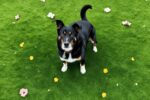Training Your Dog Not to Jump Up on People

Jumping up on people is a common dog behavior that can be both annoying and potentially hazardous. While dogs use jumping to greet and seek attention, it is important to teach them alternative ways to express their enthusiasm without resorting to jumping.
Understanding dog behavior, greeting manners, and obedience training are key components in addressing this issue. By implementing effective training techniques and promoting consistent practice, you can successfully train your dog to greet people in a more appropriate manner.
In this article, we will explore why dogs greet by jumping, the importance of behavior modification, and effective training methods to achieve the desired outcome. We will also discuss the significance of consistency and perseverance in the training process.
Join us as we delve into the world of dog behavior and learn how to foster polite greeting manners through obedience training.
Why Dogs Greet by Jumping
Understanding why dogs greet by jumping is crucial in addressing and modifying this behavior. Dogs repeat behaviors that earn them rewards, and jumping up to greet people is no exception. This behavior is reinforced through positive rewards such as attention and affection from humans.
It’s important to note that even negative reactions can inadvertently reinforce jumping behavior. Yelling at a dog or even grabbing their paws in an attempt to stop them from jumping can still provide attention and inadvertently reinforce the behavior.
In order to modify this behavior, it is essential to explore the underlying reasons why dogs engage in jumping up to greet. Canine behavior experts suggest that dogs jump up primarily to seek attention and establish social interaction. Dogs naturally crave attention and affection from their human companions, and jumping up is an instinctual way for them to get noticed.
“Dogs are social animals and thrive on attention. Jumping can be seen as a way for them to get the attention they seek,” says Dr. Emily Johnson, a veterinarian and animal behavior specialist.
By understanding the underlying motivations behind jumping behavior, pet owners can take appropriate steps to address and modify this behavior effectively.
| Reason | Rewards |
|---|---|
| Desire for attention | Affection, petting, verbal praise |
| Establishing social connection | Eye contact, physical touch |
| Excitement and anticipation | Positive verbal and physical responses |
| Seeking higher dominance status | Acknowledgment, submission from humans |
This table highlights some of the rewards that dogs receive when they jump up to greet people. These rewards reinforce the behavior and make it more likely to recur in the future. It is essential for dog owners to understand the role of rewards and attention in modifying jumping behavior and finding alternative, more appropriate greeting behaviors.
Training an Alternative Greeting Behavior
To eliminate jumping from your dog’s greeting repertoire, behavior modification techniques are essential. It is important to manage their behavior and teach them more appropriate ways to greet people. By providing clear instructions and teaching specific commands, you can create a positive and polite greeting experience.
Behavior Modification for Appropriate Greetings
Behavior modification is the cornerstone of training dogs to greet people appropriately. By understanding the root causes of jumping up, which can include excitement, attention-seeking, or even anxiety, you can address and modify this behavior effectively.
“Properly training your dog to greet people can improve their social interactions and create a harmonious environment for everyone involved.”
Teaching Commands for Greetings
Teaching specific commands is a crucial part of training an alternative greeting behavior for your dog. Two common commands that you can focus on are “four on the floor” and “sit.”
- “Four on the Floor”: Ensure that your dog keeps all four paws on the floor while greeting people. This command promotes a more controlled and respectful approach.
- “Sit”: Teaching your dog to sit on command is an effective way to redirect their attention and prevent jumping. It encourages calm behavior and provides an alternative greeting gesture.
By consistently reinforcing these commands during greetings, you can establish positive behavior patterns and eliminate jumping from your dog’s repertoire.
Creating a Training Plan
Creating a comprehensive training plan is crucial to ensure consistency and success. Consider the following steps:
- 1. Set Clear Expectations: Clearly define how you want your dog to greet people, emphasizing keeping paws on the floor and sitting.
- 2. Consistent Practice: Regular practice sessions throughout the day will reinforce the desired behavior.
- 3. Positive Reinforcement: Reward your dog with treats, praise, or play for exhibiting the desired alternative greeting behavior.
- 4. Reinforce During Real-Life Interactions: Practice the alternative greeting commands during real-life interactions with family, friends, and strangers.
- 5. Be Patient: Modifying behavior takes time, so be patient and persistent in your training efforts.
By following these steps and being consistent in your training, you can successfully teach your dog alternative greeting behaviors and ensure polite and appropriate interactions.
Training “Four on the Floor”
One effective technique to teach your dog to keep all four paws on the floor is by using treats as rewards. By rewarding your dog before they even have a chance to jump, you can reinforce the desired behavior. Consistency and timing are key in successfully training “four on the floor.”
Positive reinforcement is an essential aspect of training your dog to maintain proper greeting manners. By using treats as rewards, you can motivate your dog to exhibit the desired behavior of staying grounded. When your dog approaches a person without jumping, immediately praise and reward them with a treat. This positive reinforcement reinforces the association between calm behavior and rewards, making it more likely that your dog will continue to greet in a polite manner.
Consistency is crucial in any dog training regimen. Dogs thrive on routine and clear expectations. Therefore, it’s important to be consistent in rewarding your dog for staying on the floor during greetings. Set aside regular training sessions to practice proper greetings and reinforce the behavior with treats. This will help your dog understand what is expected of them consistently over time.
To ensure successful training, it is important to use treats that your dog finds highly motivating. Choose small, tasty treats that your dog enjoys and can consume quickly without disrupting the training flow. This will help maintain your dog’s focus and enthusiasm throughout the training process.
Remember, timing is crucial in training “four on the floor.” It is essential to reward your dog as soon as they exhibit the desired behavior of keeping all four paws on the floor. This immediate reinforcement helps reinforce the connection between the action and the reward, making it easier for your dog to understand what you expect from them.
Consistency and perseverance are key in successfully training your dog to maintain “four on the floor” during greetings. By using positive reinforcement, treating as a reward, and ensuring consistent training sessions, you can help your dog develop proper greeting manners for a lifetime.

Summary:
- Use treats as rewards to reinforce the desired behavior of keeping all four paws on the floor during greetings.
- Consistency is crucial in training. Set aside regular training sessions and practice proper greetings consistently.
- Choose small, tasty treats that your dog finds highly motivating to maintain their focus and enthusiasm.
- Timing is key. Reward your dog immediately for exhibiting the desired behavior.
Training “Sit” for Greetings
While teaching your dog alternative greeting behaviors, another effective method is training them to sit. Sitting is an incompatible behavior with jumping up, as it keeps all four paws on the ground and promotes a calm greeting. By reinforcing the sit command, you can redirect your dog’s attention and discourage jumping.
Consistent practice is essential in training your dog to sit for greetings. Start by teaching the sit command in a controlled environment, such as your home or backyard, where distractions are minimal. Use positive reinforcement techniques, such as treats or praise, to reward your dog for sitting calmly.
Here’s a step-by-step guide to training “sit” for greetings:
- Start with your dog in a calm state, standing or sitting at your side.
- Hold a treat close to your dog’s nose, then slowly move it upwards and towards the back of their head. This natural motion will encourage them to naturally sit down.
- As soon as your dog’s bottom hits the ground, praise and reward them with a treat.
- Repeat this process several times, gradually reducing the use of treats and relying more on verbal praise.
- Once your dog consistently sits when prompted, start practicing the sit command in different locations and with increasing distractions.
Remember, consistency is key to effective training. Practice the sit command regularly and reinforce calm behavior during greetings. Over time, your dog will learn that sitting is the preferred way to greet people and will be less likely to jump up.
Training “sit” for greetings not only helps address the issue of jumping up, but it also creates a positive and polite interaction between your dog and others. By teaching this alternative behavior, you can ensure your dog’s greetings are calm and well-mannered.

Preventing Jumping While You Train
While training your dog not to jump, it is crucial to implement behavior management strategies to control their actions and avoid reinforcement of unwanted behaviors. By controlling the situations in which your dog may be tempted to jump, you can create a conducive environment for effective training. Leash training, crating, and confining to another room are practical techniques that can assist in managing your dog’s behavior during training sessions.
Leash training is a valuable tool in controlling your dog’s movements and preventing them from jumping during training. By securely attaching a leash to your dog’s collar or harness, you can maintain physical control and guide their behavior. The leash provides you with the ability to redirect your dog’s attention, maintain appropriate distance from people, and reinforce desired behaviors while discouraging jumping.
Crating your dog during training sessions can be highly effective in preventing jumping. Dogs naturally seek comfort and security in enclosed spaces, making a crate an ideal tool for behavior management. By confining your dog to a crate, you create a controlled environment where they are less likely to engage in unwanted behaviors such as jumping. This confinement can help to minimize distractions and focus your dog’s attention on the training exercises.
Another approach to preventing jumping while you train is to confine your dog to another room. This technique separates your dog from the training area, allowing you to conduct sessions without the risk of them practicing jumping. By confining your dog to a designated space, such as a separate room or gated area, you can control their proximity to people and ensure a calm and controlled environment for training.
Expert Tip: When implementing behavior management strategies to prevent jumping, it is important to remember that consistency is key. Continuously reinforcing your training methods by consistently applying leash training, crating, or confining techniques will help your dog understand what is expected of them and discourage the unwanted behavior of jumping.
Favorable Conditions for Training
To provide optimal conditions for training, it is essential to choose a comfortable and distraction-free location. Find a quiet area within your home or outdoors, away from potential triggers that may evoke jumping behaviors. This controlled environment will help your dog remain focused on the training exercises and facilitate the learning process.
Additionally, ensure that you have all the necessary training tools at hand, such as treats, clickers, or target sticks, to reward desired behaviors and reinforce positive associations. These tools can enhance the effectiveness of your training sessions and encourage your dog’s participation and cooperation.
| Techniques | Description |
|---|---|
| Leash Training | Using a leash to control your dog’s movements and redirect their attention during training sessions. |
| Crating | Confining your dog in a crate during training to create a controlled environment and minimize distractions. |
| Confining to Another Room | Separating your dog from the training area by confining them to a designated room or gated area. |
Consistency and Perseverance in Training
To effectively train your dog not to jump, it’s crucial to prioritize consistency, timing, and perseverance. By employing these key factors, you can maximize the success of your training efforts and achieve the desired outcomes. In this section, we will explore the importance of timely rewards, everyone’s involvement, and training persistence.
Timely Rewards
One of the most effective ways to reinforce desired behavior is through timely rewards. When your dog greets people without jumping, make sure to provide immediate positive reinforcement. This can be in the form of treats or verbal praise. By associating good behavior with rewards, your dog will be more motivated to exhibit appropriate greetings.
Everyone’s Involvement
Consistency is key when training your dog. It’s essential that everyone in your household follows the training program consistently. Inconsistent responses to jumping behavior can confuse your dog and hinder progress. Ensure that all family members are aware of the training techniques and actively participate in implementing them. By presenting a unified front, you can establish a clear set of expectations for your dog.
Training Persistence
Training your dog not to jump requires patience and persistence. It’s important to remember that behavior modification takes time. Dogs learn through repetition and reinforcement. Stick to the training program even if you don’t see immediate results. Consistently apply the techniques outlined in this article, and be patient with your dog’s progress. With persistence, you will see positive changes in your dog’s greeting manners.
Remember, timely rewards, everyone’s involvement, and training persistence are crucial components of successfully training your dog not to jump. By implementing these strategies, you can promote polite greetings and improve your dog’s overall behavior.
| Key Factors | Benefits |
|---|---|
| Timely Rewards | Reinforces desired behavior and motivates your dog to exhibit appropriate greetings. |
| Everyone’s Involvement | Ensures consistency in responses to jumping behavior and establishes clear expectations for your dog. |
| Training Persistence | Promotes long-term behavior change by consistently applying training techniques and being patient with progress. |
Conclusion
Training your dog not to jump up on people is crucial for promoting good manners and ensuring their safety. By understanding the reasons behind jumping behavior, implementing effective training techniques, and maintaining consistency, you can successfully modify this behavior and foster polite greetings.
Jumping up is a natural canine behavior that dogs use to greet and seek attention. However, it can be annoying and even dangerous for humans. By teaching your dog alternative greeting behaviors, such as keeping all four paws on the floor or sitting, you can promote better manners and ensure a positive interaction.
Consistency, timing, and perseverance are key factors in training your dog not to jump. By rewarding desired behavior, ignoring jumping, and involving everyone in the training process, you can achieve success in modifying your dog’s greeting behavior. Remember to provide timely rewards, consistently follow the training program, and ensure that all people your dog interacts with also ignore jumping.
By applying these training techniques and consistently practicing them, you can help your dog develop good manners and create a safer and more enjoyable environment for everyone. Start your obedience training journey today and experience the joy of well-behaved and polite greetings with your furry companion.
FAQ
Why do dogs jump up on people?
Dogs jump up on people as a natural behavior to greet and seek attention. However, it can be annoying and even dangerous for humans.
How can I stop my dog from jumping up on people?
To stop your dog from jumping up on people, it is important to manage their behavior and teach them an alternative, more appropriate way to greet people.
What are the alternative greeting behaviors I can teach my dog?
You can teach your dog to keep all four paws on the floor or to sit as alternative greeting behaviors.
What is the best way to train my dog to keep all four paws on the floor?
One effective technique is using treats as rewards to reinforce the desired behavior of keeping all four paws on the floor.
How can I train my dog to sit as a greeting behavior?
By consistently practicing and rewarding the “sit” command, you can redirect your dog’s attention and discourage jumping up during greetings.
How can I prevent my dog from practicing jumping while training?
You can use techniques such as crating, confining to another room, or restraining on a leash to manage your dog’s behavior and prevent them from jumping while training.
What are the key factors in training my dog not to jump?
Timing, consistency, and perseverance are important in training your dog not to jump. Ignoring jumping behavior, involving everyone in the training program, and ensuring consistent responses from all the people your dog interacts with are crucial for positive results.
Why is training my dog not to jump up on people important?
Training your dog not to jump up on people is important for promoting good manners and ensuring their safety during greetings.






